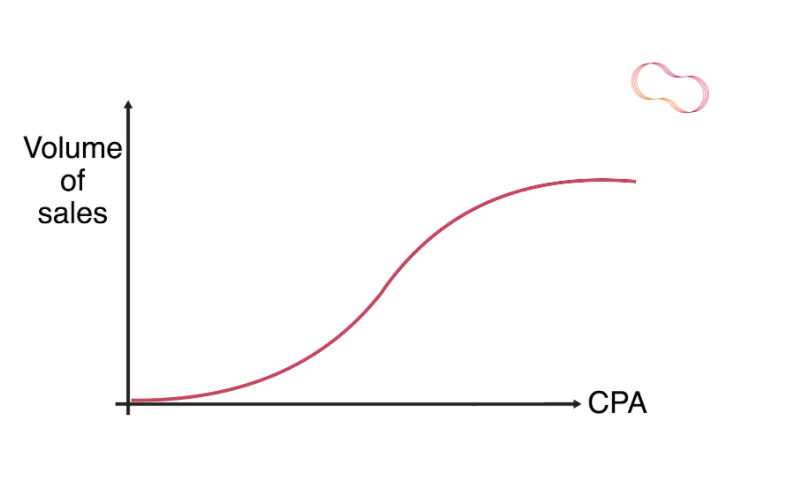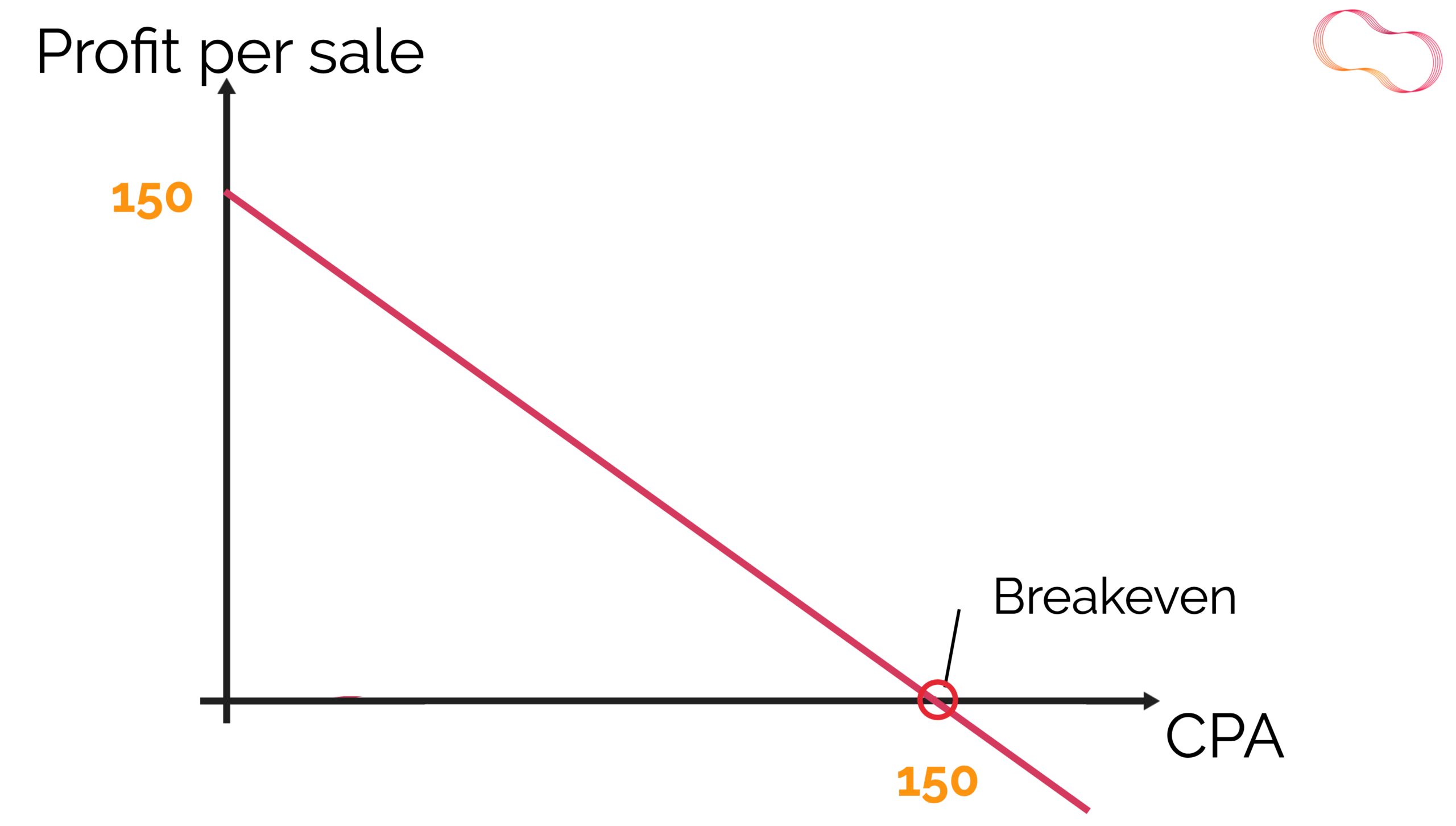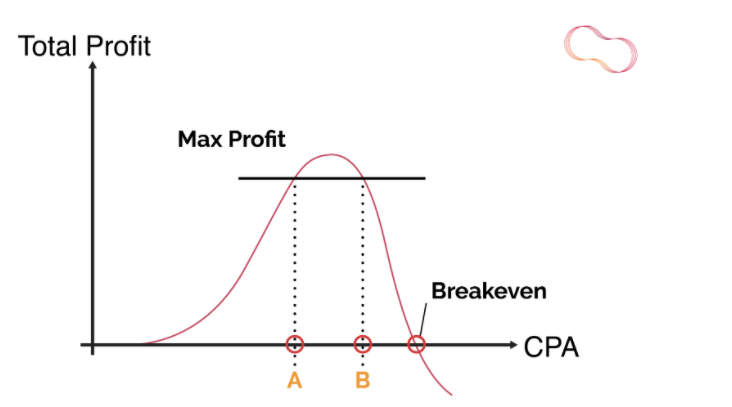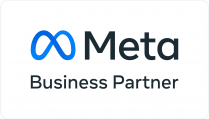If you’re a VC-backed startup happy to burn through cash in the myopic pursuit of ‘growth at all costs’ and you hope you might hit profit sometime before 2030, then let me save you 11 mins – you can stop reading now.
But if you have a board, or manager, or accountant breathing down your neck… someone that maybe doesn’t understand marketing with the nuance that you do – this is for you.
This will give you a simple image you can show to your board & the “convince your boss” narrative so that they finally get it 🙂
Likewise if you’ve bounced from agency to agency chasing “lower CPAs” then you’ll going to love this… as long as you can accept that might not be the best thing to ask for in the future. Let’s dig in.
Why do I love the Profit Curve?
For years I’d roll my eyes (inwardly) when a new prospect said to me some variation on “we’re getting leads for $70 but we need that CPA to be lower”.
I knew that wasn’t going to get them the best result, but I didn’t have the tool to show them WHY & worse, I couldn’t show them a better way.
I struggled with this. I even fired a couple of clients that kept moving the goalposts… every time we hit their new goal they’d keep squeezing the target down. Which is fair… to a point. But you can’t reasonably expect $30 leads in a market where your competition is happy to pay $100.
I searched for a way to explain this – and I’m very visual – so it had to be something I could sketch on a whiteboard, or a napkin while drinking a glass of Australian Shiraz!
Eventually after many attempts (& a few vinos) I hit upon the simplicity of the Profit Curve.
My hope is it will help you (& others) understand the profitability of your marketing at a glance, and make it easier to test your assumptions & set (and hit) even better marketing objectives.
Let’s start at the start
Assume for a moment you have a website that generates leads consistently.
Better yet, you’re running paid ads, sending people to your offer every day & there’s room to scale.
You outsourced the ads to an agency (X), but you were pressured to change & chase lower costs.
When Agency X ran ads the cost of acquiring each lead (CPA) was $70
Then Agency Y promised the earth, changed a few settings & now CPA is $30
Which situation/agency is better?
Let’s assume that the conversion rate from lead to sale for both is identical. And, to keep the maths easy, let’s say both campaigns generate 1 new customer for every 10 leads they bring in.
It seems obvious. $30 is better than $70 right?
Well… it depends. To answer that question we need context.
What’s your Breakeven Point?
We first need to understand how much that new customer is worth to your business & therefore what your breakeven cost per lead (BE) is.
If we make $500 from each customer (& it takes 10 leads to gain one customer), then our BE is $50.
At which point Agency X was losing money every time an ad ran – easy decision.
But if a customer is worth $5000, and our BE is $500, well then it matters less, but you’d still rather pay $30 instead of $70 right?
But there’s one more critical factor to consider. The volume of leads.
How many Leads can you get?
Let’s assume our BE is $150.
When the CPA was $70 you got 200 leads every month (assume for a moment there’s no capacity constraint & your business can handle an unlimited supply of leads)
But when the CPA dropped to $30, the volume dropped too. Now you only get 50 leads a month.
Now which is better?
To figure that out, we need to look at the total profit per month each Agency was generating.
I’ll simplify even more here by not adding in agency fees, but you may want to add those to your calculations.
Profit = The average profit per lead (breakeven less costs) multiplied by the total number of leads
So, X = (150 – 70) x 200 = 80 x 200 = $16,000/month
And Y = (150 – 30) x 50 = 120 x 50 = $6,000/month
Interesting!
And yet, the board keep wanting you to reduce that pesky CPA!
Let’s look at Volume
Let’s just focus on Search ads for a moment here (display, shopping, facebook & other type of ads each have their own idiosyncrasies).
For each Keyword, generally the more we’re willing to pay per lead, the more leads we can get.
Up to a point
But… There comes a point where paying more doesn’t get many (or even any) more leads. There are only so many people searching for each keyword each day (yes I’m over-simplifying here, go with it).
So we can picture the volume of leads changing as the CPA changes.
At first it goes up, but eventually flattens off. An ‘S’ curve.

Average Profit per Lead
This is easier. It’s a straight line. It’s just our Breakeven minus the cost of acquiring the leads (for simplicity I’m just including our ad cost – you might want to add a fixed cost here too).
So, if we could magically get leads for $0, we’d make the maximum profit of $150 (if our BE is $150).
And if we paid $150 per lead, our profit per lead would be $0.

Total Profit
Now combine these two to get our Total Profit, we know we make $0 profit when the CPA is $0 (assuming we’re not magicians & we can’t get any free leads!)
And we also make $0 profit when the CPA is $150 – it doesn’t matter how many leads we get if the average profit per lead is $0!
Anything in between $0 & $150 nets us a profit (we don’t know how much yet, but we know that’s profitable), and an average higher than $150 would lose money.
Which gives us (at least in theory at this point) our ‘Profit Curve’

What’s your Goal?
Now all you need to do is work out how much profit you want to make from those leads.
Now if you’re yelling “duh, maximum profit please…” at your device, then hear me out.
Your profit target depends on a couple of things… and again I’ll over-simplify here.
Your business model
There are two main types of business.
Those that sell a product or service once – for example if you sell garage doors, or coffins you’re not expecting the same customer to buy again & again from you.
And those businesses that sell on a recurring basis – for example accountants that charge an annual retainer, an online store selling a wide range of products (Shiraz FTW!), or a local bookstore with loyal customers.
Of course we’re ignoring the power of referrals here (& the benefits of building a great referral system).
If you’re only going to deal with someone once, you probably want to maximise your profits from that exchange.
However if you recognise that delighting a customer will bring them back again & again, and you’ve done the work to figure out your average ‘Lifetime Value’ (LTV) per customer. Then you might be willing to make a lot less, maybe even nothing, on that first sale.
This depends on your mindset & the time-frame you use to judge the success of your marketing.
Your Marketing Mindset
There are 3 main ‘buckets’ businesses fall into here.
The short-term business that looks at all marketing expenses as a cost generally wants to make money now. These are the businesses that always want “cheaper leads”.
The smart business that understands LTV, knows that profit will follow. They realise that buying more leads isn’t a cost but an investment. They also realise the fastest way to grow their business is to acquire the maximum number of leads – which means NOT making a profit on the initial transaction, but to acquire them at breakeven and profit over time.
The third bucket is much smaller. These businesses really know their numbers & are willing to ‘go negative’ & actually lose money on the first transaction, because they realise doing so gives them an edge over competitors & they can afford to ‘buy’ even more leads that way.
As Dan Kennedy once said “the winner is not the business that gets the cheapest leads, but the business that can afford to spend the most to acquire a new customer!”
Maximizing Profit is tricky.
Let’s simplify the story so far…
You have a choice – max profit or zero profit (at first)
For now I’ll assume you want to make a profit 🙂
But hitting that ‘Max Profit’ is actually very hard, so let’s make it a bit easier & chop the top off our profit curve, so we now aim for a ‘max profit zone’. Anywhere between A & B below.

So which will you choose? A CPA of $A or $B?
In a world of AI & Machines running most of the bidding this matters more than ever.
The Profit Curve in a Machine world
Let’s continue to assume out BE is $150, then point A on the curve above is roughly $100 & point B is $130.
Again, which would you choose? $100 per lead or $130?
It’s tempting to say $100 right?
After all, they both end up with the same Total Profit (slightly less than the theoretical maximum).
Both the ‘right’ answer here is $130. Why?
Google isn’t optimising for your profit!
If 2 businesses are competing for the same keyword, one offers the machine $100 per lead & the other offers $130, who do you think wins that auction? Who’s money does the machine want to take?
Of course, $130 every time.
Your first customer is not the human seeing your ad – your first customer is the dispassionate Machine that runs the auction & wants to maximise profits for the owner of that machine!
To be attractive to the Machine, you want to offer $130 when everyone else is offering $100 (& many of them are still only offering $50!)
But there’s another huge reason
Something serial entrepreneur & podcast host Kathleen Booth calls this the Value of Volume!
Remember the total profit for both A & B is the same (the same point on the y axis on our curve).
And profit is the average profit per lead multiplied by the total number of leads.
So if point A nets an average profit per lead of $50 (150-100) and B is only $20, then we must have about 2.5 times as many leads at point B in order for the total profit to be the same.
I know… mind-bending right!
Think about what your business would look like with 2.5x the volume of leads.
What does that do for your website optimisation? Your email split testing?
Your case studies & testimonials? Your referrals?
The value of your business!?
Any way you slice it, you’re much, much better off with a lot more leads coming in the door.
You can be more picky with who you take on. What Dan Sullivan calls ‘freedom of relationship’/
You have more training opportunities for your team.
Life is just better.
So the big question you’re probably asking yourself right now is..
“What is MY profit curve?”, “What does that look like for my marketing campaigns?”
Well in the past, the only way to try & figure it out was good old-fashioned testing.
Testing different CPA amounts, seeing what happened to your lead volume & calculating your profit.
But that was then. Now Google have a little-known tool, buried in their Google Ads platform, that uses real-world data (& a whole lot of statistical modelling) to show you how your volume of leads will change as you change your CPA target.
And in the next part of this post, I’ll show you how you can use this tool, how to calculate the missing piece that Google won’t tell you.
For now, go show the curve to whoever approves your marketing budget & start having some interesting conversations…








